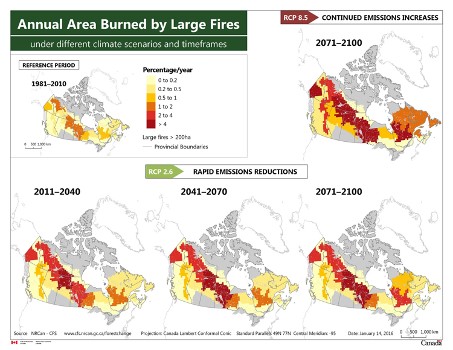Forest fires
The effects of climate change on forest fires are already being felt. However, climate forecasts raise fears of higher intensity, frequency and surface area of fires in the coming years. Forest fires are expected to increase, particularly due to rising temperatures and a decrease in humidity in the air and soil and water availability. The lengthening of the tree growth period as the climate warms may also increase the risk of wildfires by increasing the fuel available.
More frequent forest fires
Increase in annual area burned
Increase in the number of large fires
Longer fire season
More frequent forest fires
An increase in the frequency of wildfires is predicted due to the drying of fuels accentuated by rising temperatures. This will have the effect of altering the historical fire patterns that forest ecosystems are accustomed to. According to current projections, the frequency of fires in Quebec will increase, depending on the emission scenario, by 50 to 100% by the end of the century compared with the 1961-1999 reference period.
Increase in annual area burned
The annual area burned in Quebec is expected to increase in size due to the likely increase in drought conditions. This is the main reason for the increase in forest fires in the province, and a slight increase in precipitation will not compensate for the drying caused by warmer temperatures. However, these projections exclude southeastern Quebec, which has a generally wetter climate.
According to climate models, in the optimistic greenhouse gas emissions scenario (RCP2.6), the area of burned forest in Canada could double by 2100. By contrast, the most pessimistic scenario (RCP8.5) predicts three to four times more burned area by the end of the century.

Figure 3 : Projected increase in annual area of forest burned in Canada in millions of hectares by the end of the century in the RCP2.6 and RCP8.5 scenarios. (From: NRCan, 2020).
Increase in the number of large fires
Projections indicate that the number of large fires, i.e. over 200 hectares, will also be higher. In Quebec, the regions most affected, both in terms of the number of large fires and the size of the fires, are expected to be in the north and west of the province, regardless of the GHG emission scenario used.

Figure 4 : Projected number of fires over 200 hectares in Canada in the RCP2.6 and RCP8.5 GHG emission scenarios. (From: NRCan, 2020).

Figure 5 : Projected increase in annual area burned by large fires in the RCP2.6 and RCP8.5 scenarios.
Longer fire season
Forest fire seasons are likely to last longer, due in part to earlier snowmelt combined with warmer autumns in many parts of Quebec. In some areas of the province, the fire season could therefore be 3 weeks to a month longer in 2100 compared to the reference period of 1981-2010. The number of fire weather days could rise by 26% to 200% by the end of the century.
Return to the observed changes
Consult the impacts of forest fires